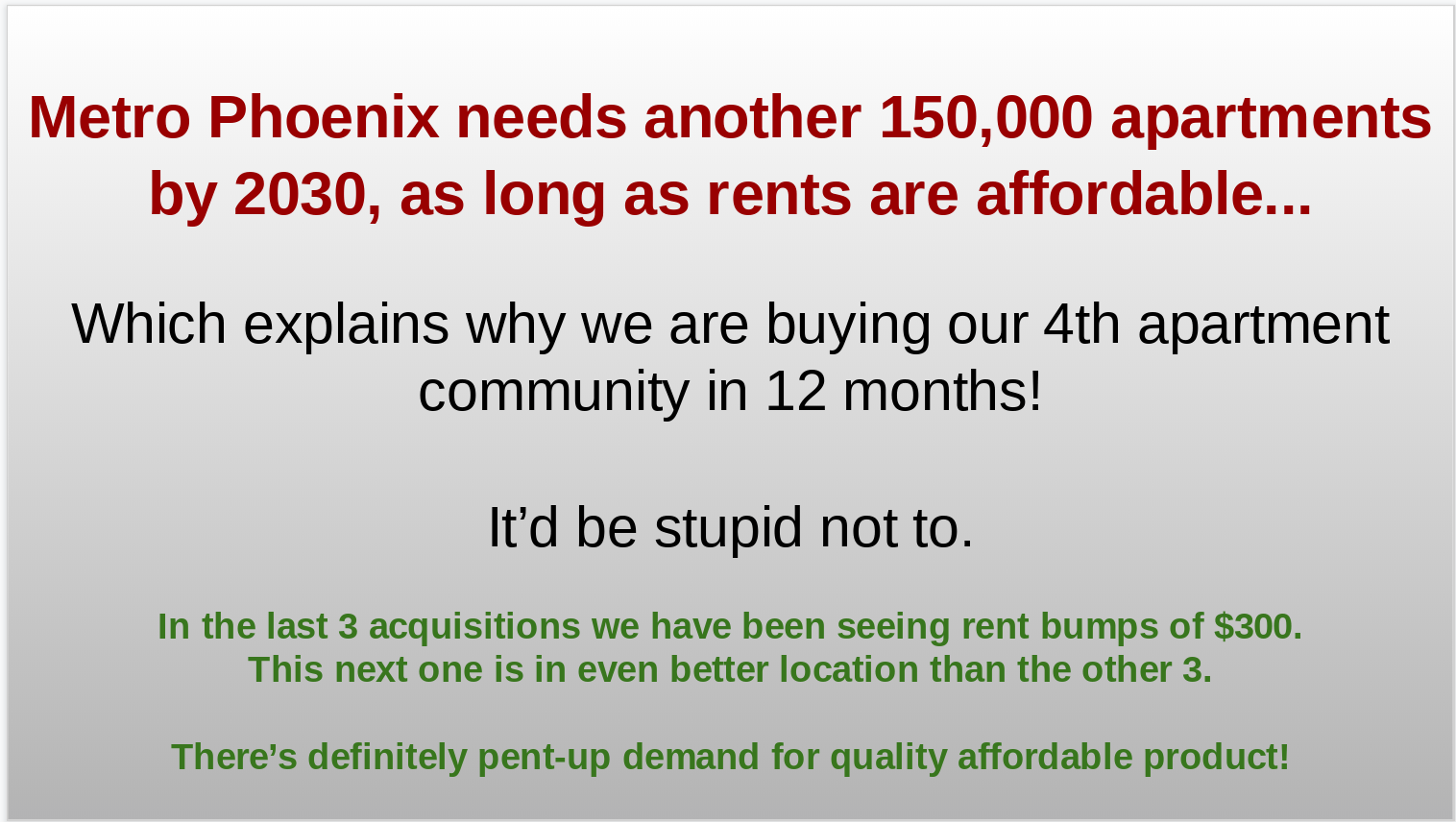This has been an insane year so far…and that may very well be an understatement.
Sam and I bought three apartment communities in 12 months, and we will be closing on another one soon.
I’ve been very busy, and this has manifested in many ways, one of which has been lack of new articles on this blog. And I feel bad about it. I like to teach…
I’ve Got a Solution
While it’s true that I am really busy and don’t have much time to write, it occurred to me that there is plenty being written in the media, and I can simply reference that in order to illustrate my point of view, and explain why I do what I do.
Why We Re Buying 4th Apartment Community
I mean, I did not have to go crazy at first. I could have eased into things. Instead, though, I went nuts, and the community we are under contract for will be our 4th acquisition in 14 months.
The article by Catherine Reagor, which appeared in Arizona Republic on 9/22/2019, explains my global perspective. Feel free to reach out to discuss anything you read:
Metro Phoenix needs another 150,000 apartments by 2030, as long as rents are affordable
Metro Phoenix needs another 150,000 new apartments in the next decade.
That’s more than 10,000 a year, according to the apartment industry’s latest research.
Anyone who’s visited central Phoenix, Scottsdale or Tempe lately, where there are dozens of new apartment complexes and renovated older ones, might be shocked by that number.
About 27,000 new apartments have been built in the Valley since 2016, according to Colliers International. Another 14,000 are under construction and 21,000 planned.
What’s driving the apartment boom?
More people are moving to the Valley for new jobs, and incomes did increase this year.
Most people who move to new cities rent first.
- Maricopa County, home to metro Phoenix, drew more new residents than any other county in the nation during the past three years, according to the U.S. Census. The Valley added 81,244 people between July 2017 and July 2018, the latest period tracked.
- Metro Phoenix posted the biggest increase in jobs in the U.S. — 3.2% — during the past year, per a count from the Bureau of Labor Statistics. That growth translates to about 66,500 new jobs.
- Arizona incomes grew by 5.5% during the first quarter of this year, faster than the national rate of 3.4%, the U.S. Bureau of Economic Analysis reports.
But that increase in incomes still isn’t enough for most to afford one of the Valley’s new apartments.
Who’s renting
About 90% of the apartments built so far are in luxury complexes with average monthly rents of nearly $1,500.
Many of metro Phoenix’s new residents and companies bringing jobs are coming from pricier areas, particularly California. The Valley’s housing market is a deal compared with San Francisco, Los Angeles and San Diego.
New apartments are filling up as the occupancy rate Phoenix area is nearly 96%, according to Colliers. That rate includes many of the new high-end apartments.
But many apartment owners are offering deals to fill their complexes. Signs advertising perks such as free rent for a month or two can be seen at many of the new luxury complexes as well as older ones.
I have also heard from many renters in their 20s who are sharing bedrooms and even sleeping on couches to afford the pricier rents.
Who can afford the rents?
Valley apartments aren’t a deal for many already working and living here.
The average apartment rent in metro Phoenix is up nearly 9% to about $1,170. Valley rents have been climbing by more than 6% a year since 2014.
Almost half of Arizona’s workforce earns between $25,000 and $75,000 a year, according to research from the Arizona Multihousing Association released earlier this year. It posted the new data on the number of apartments needed in the Valley by 2030 last week.
More housing priced for the state’s workforce needs to be built. People making $50,000 a year can afford about $1,000 in rent a month without being stretched to pay other important bills including food, transportation and health care.
“The supply that is being planned and built appears to be primarily in high end of the market,” said Courtney LeVinus, CEO of the state’s apartment association. “There is a need and strong demand for reasonably priced housing in all forms that are close to employment centers and transportation.”
Metro Phoenix will need more apartments if it keeps growing at the same rate. But those homes will have to be more affordable to keep drawing and keep people in the Valley.


3 Comments